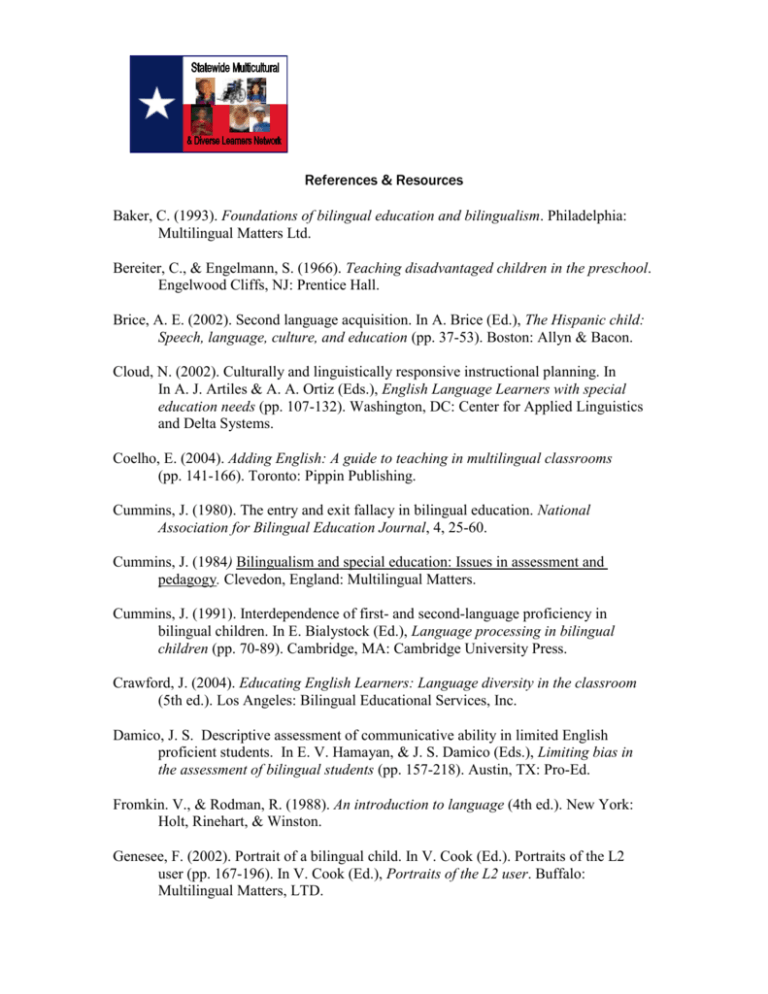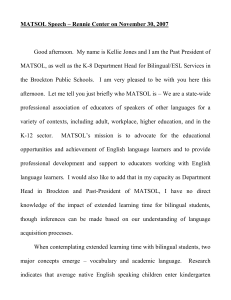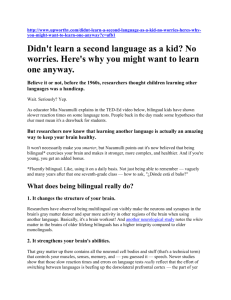Lang_12.1.09 References_Resources_(2)
advertisement

References & Resources Baker, C. (1993). Foundations of bilingual education and bilingualism. Philadelphia: Multilingual Matters Ltd. Bereiter, C., & Engelmann, S. (1966). Teaching disadvantaged children in the preschool. Engelwood Cliffs, NJ: Prentice Hall. Brice, A. E. (2002). Second language acquisition. In A. Brice (Ed.), The Hispanic child: Speech, language, culture, and education (pp. 37-53). Boston: Allyn & Bacon. Cloud, N. (2002). Culturally and linguistically responsive instructional planning. In In A. J. Artiles & A. A. Ortiz (Eds.), English Language Learners with special education needs (pp. 107-132). Washington, DC: Center for Applied Linguistics and Delta Systems. Coelho, E. (2004). Adding English: A guide to teaching in multilingual classrooms (pp. 141-166). Toronto: Pippin Publishing. Cummins, J. (1980). The entry and exit fallacy in bilingual education. National Association for Bilingual Education Journal, 4, 25-60. Cummins, J. (1984) Bilingualism and special education: Issues in assessment and pedagogy. Clevedon, England: Multilingual Matters. Cummins, J. (1991). Interdependence of first- and second-language proficiency in bilingual children. In E. Bialystock (Ed.), Language processing in bilingual children (pp. 70-89). Cambridge, MA: Cambridge University Press. Crawford, J. (2004). Educating English Learners: Language diversity in the classroom (5th ed.). Los Angeles: Bilingual Educational Services, Inc. Damico, J. S. Descriptive assessment of communicative ability in limited English proficient students. In E. V. Hamayan, & J. S. Damico (Eds.), Limiting bias in the assessment of bilingual students (pp. 157-218). Austin, TX: Pro-Ed. Fromkin. V., & Rodman, R. (1988). An introduction to language (4th ed.). New York: Holt, Rinehart, & Winston. Genesee, F. (2002). Portrait of a bilingual child. In V. Cook (Ed.). Portraits of the L2 user (pp. 167-196). In V. Cook (Ed.), Portraits of the L2 user. Buffalo: Multilingual Matters, LTD. Goodz, N. (1994). Interactions between parents and children in bilingual families. In F. Genesee (Ed.), Educating second language children: The whole child, the whole, curriculum, the whole community (pp. 61-81). Cambridge, England: Cambridge University Press. Marzano, R. J., Pickering, D. J., & J. E. Pollock, J.E. (2001). Classroom instruction that works. Alexandria, VA: ASCD. Northcutt, L., & Watson, D. (1986). Sheltered English teaching handbook. Carlsbad, CA: Northcutt, Watson, Gonzales. Pool, F. & Voran, H. (2007). Limited English Proficiency Student Success Initiative Supporting English Language Learners in English as a Second Language Stand TALL Teachers Accessing Language Learning in Texas Training of Trainers. Ortiz, A. A., & Garcia, S. B. (1990). Using language assessment data for language and instructional planning for exceptional bilingual students. In A. Carrasquillo & R. Baecher (Eds.), Teaching the bilingual special education student (pp. 24-47). Norwood, NJ: Ablex. Ortiz, A. A., & Kushner, M. I. (1997). Bilingualism and the possible impact on academic performance. In Silver, L. (Vol. Ed.), Child and Adolescent Psychiatric Clinics of North America, Vol. 6, No. 3 (pp. 657-679). Philadelphia: W. B. Saunders Company. Ortiz, A. A., & Yates, J. R. (2002). Considerations in the assessment of English Language Learners referred to special education. In A. J. Artiles & A. A. Ortiz (Eds.), English Language Learners with special education needs: Identification, Assessment, and Instruction (pp. 65-85). Washington, DC: Center for Applied Linguistics and Delta Systems. Padolsky, D. (2004). How many school-aged English language learners (ELLs) are there in the U.S.? Ask NCELA No.1. Washington, DC:George Washington University, National Clearinghouse for English Language Acquisition and Language Instructional Programs. Available: <http://www.ncela.gwu.edu> Region 4 Education Service Center. (2005). Bilingual phenomena: Determining a communication difference vs a communication disorder. Houston, TX: Author. Thomas, W., & Collier, V. (2002). A national study of school effectiveness for language minority students' long-term academic achievement. Santa Cruz, CA and Washington, DC: Center for Research on Education, Diversity & Excellence. Available: <http://www.crede.ucsc.edu/research/llaa/1.1_final.html> van Keulen, J. E., Weddington, G. T., & DeBose, C. E. (1998). Speech, language, learning, and the African American child. Boston: Allyn & Bacon. Wolfram, W., Adger, C. T., Christian, D. (1999). Dialects in schools and communities. Mahwah, NJ: Lawrence Erlbaum Associates, Publishers.








